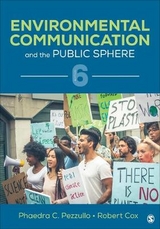
Environmental Communication and the Public Sphere
SAGE Publications Inc (Verlag)
978-1-5063-6359-2 (ISBN)
- Titel erscheint in neuer Auflage
- Artikel merken
Phaedra C. Pezzullo is Associate Professor at the University of Colorado Boulder, and a dual citizen with the US and Italia. Her interdisciplinary background informs her research on environmental justice, climate justice, just transition, public advocacy, and tourist studies. Her book, Toxic Tourism (University of Alabama Press, 2007), won four awards, including the Jane Jacobs Urban Communication Book Award and the National Communication Association’s Environmental Communication Division Book Award. Among other publications, she coedited Green Communication and China (Michigan State University Press, 2020) and Environmental Justice and Environmentalism (MIT Press, 2007). She was a founding editor of the journal Environmental Communication and serves on its editorial board. She has volunteered on the Sierra Club’s national Environmental Justice Committee and Affinity Group Working Group, consulted with cities and counties on a just transition, and was a delegate at COP21 in Paris. Pezzullo is a founding co-director of the Center for Creative Climate Communication and Behavior Change (C3BC) on her campus. She also enjoys outdoor recreation and cooking a plant-based diet. Robert Cox is Professor Emeritus at the University of North Carolina at Chapel Hill. His principal research areas are environmental and climate change communication and strategic studies of social movements. A internationally-recognized leading scholar who helped found the field of environmental communication, Cox is coeditor of The Routledge Handbook of Environment and Communication (2015; second edition forthcoming), editor of the four-volume reference series Environmental Communication (Sage, 2016), and the author of numerous studies of environmental and climate change campaigns. He has served three times (1994-1996; 2000-2001; 2007-2008) as president of the Sierra Club, the largest grassroots U.S. environmental organization, and was also on the board of directors for Earth Echo International, whose mission is “to empower youth to take action that restores and protects our water planet.” Cox also continues to advise environmental groups on their communication programs. He regularly participates in environmental and climate change initiatives and has campaigned with former vice president Al Gore, singer Melissa Etheridge, and other public figures. He also enjoys hiking and trekking in the Himalayas, Europe, and the southern Appalachian Mountains in the United States.
Part 1: COMMUNICATING FOR/ABOUT THE ENVIRONMENT
Chapter 1: Defining Environmental Communication
What is “Environmental Communication”?
Ways of Studying Environmental Communication
The Ethics of Crisis and Care
Communication, the Environment, and the Public Sphere
Communication as Symbolic Action: Wolves
Why Communication Matters to “The Environment”
Public Spheres as Democratic Spaces
Diverse Environmental Voices in the Public Sphere
Citizens and Civil Society
Nongovernmental Organizations
Politicians and Public Officials
Businesses
Scientists and Scholars
Journalists
Summary
Suggested Resources
Key Terms
Discussion Questions
Chapter 2: Contested Meanings: A Brief History
Learning to Love Nature
Wilderness Preservation Versus Natural Resource Conservation
John Muir and the Wilderness Preservation Movement
Gifford Pinchot and the Conservation of Natural Resources
Cultivating an Ecological Consciousness
Public Health and the Ecology Movement
Rachel Carson and the Public Health Movement
Earth Day and Legislative Landmarks
Environmental Justice: Linking Social Justice and Environmental Quality
Redefining the Meaning of “Environment”
Defining Sacrifice Zones and Environmental Justice
Movements for Sustainability and Climate Justice
Introducing Sustainability
Moving Toward Climate Justice and a Just Transition
Summary
Suggested Resources
Key Terms
Discussion Questions
Part II: Constructions of the Environment
Chapter 3: Symbolic Constructions of the Environment
A Rhetorical Perspective
Terministic Screens and Naming
Constructing an Environmental Problem: The “Rhetorical Situation”
Tropes and Genres
Dominant and Critical Discourses
Summary
Suggested Resources
Key Terms
Discussion Questions
Chapter 4: The Environment in/of Visual and Popular Culture
The Environment and Popular Culture
Encoding/Decoding Environmental Media
Media’s Lifecycle
Looking at the Environment
Visual Rhetoric and Nature
Seeing the American West
Picturing the Arctic National Wildlife Refuge
Moving Images of Disasters
Witnessing Ecological Crises
Polar Bears as Condensation Symbols
Pollution in Real Time
Green Art, Marketing, and Graphic Design
Environmental Art
Viral Marketing
Failed Persuasion
Green Graphic Design
Summary
Suggested Resources
Key Terms
Discussion Questions
Chapter 5: Environmental Journalism
Growth and Changes in Environmental News
Emergence and Cycles in Environmental News
A Perfect Storm: Decline of Traditional News Media and Rise of Digital News
Breaking News and Environmental Journalism
Newsworthiness
Media Frames
Norms of Objectivity and Balance
Political Economy of News Media
Gatekeeping and Newsroom Routines
Media Effects and Influences
Agenda Setting
Narrative Framing
Cultivation Analysis
Media Engagement Continuum
Digital Technologies and the Transformation of Environmental News
Digitizing Environmental Journalism
Social Media and Citizen Environmental Journalism
Summary
Suggested Resources
Key Terms
Discussion Questions
Part III: Communicating in an Age of Ecological Crises
Chapter 6: Scientists, Technology, and Environmental Controversies
Scientific Argumentation
Symbolic Legitimacy and the “Eclipse” of the Public
Fracking and the Environmental Sciences
The Precautionary Principle
Uncertainty and Risk
The Precautionary Principle
Early Warners: Environmental Scientists and the Public
Dilemmas of Neutrality and Scientists’ Credibility
Environmental Scientists as Early Warners
Science and the Trope of Uncertainty
A Trope of Uncertainty
Challenging the Environmental Sciences
Communicating Climate Science
Climate Scientists Go Digital
Media and Popular Culture
Inventing New Climate Change Messages
Summary
Suggested Resources
Key Terms
Discussion Questions
CHAPTER 7: HUMAN HEALTH AND ECOLOGICAL RISK COMMUNICATION
Dangerous Environments: Assessment in a Risk Society
Risk Assessment
Technical Risk Assessment
A Cultural Theory of Risk Assessment
Communicating Environmental Risks in the Public Sphere
A Technical Model of Risk Communication
A Cultural Model of Risk Communication
Citizens Becoming Scientists
Mainstream News Media and Environmental Risk
News Media Reports of Risk: Accurate Information or Sensational Stories?
Whose Voices Speak of Risk?
Summary
Suggested Resources
Key Terms
Discussion Questions
CHAPTER 8: SUSTAINABILITY AND THE “GREENING” OF CORPORATIONS AND CAMPUSES
Sustainability: An Interdisciplinary Approach
Economic Discourse and the Environment
Corporate Sustainability Communication: Reflection or Deflection?
Green Product Advertising
Green Image Enhancement
Green Corporate Image Repairs
Greenwashing and the Discourse of Green Consumerism
Corporate Greenwashing
Discourse of Green Consumerism
Communicating Sustainability on and Through Campuses
Communicating Sustainability Curricula
Communication Through Infrastructure
Communication Education at Tourist Sites
Summary
Suggested Resources
Key Terms
Discussion Questions
Part IV: Environmental Campaigns and Movements
CHAPTER 9: ADVOCACY CAMPAIGNS AND MESSAGE CONSTRUCTION
Environmental Advocacy
Campaigns Differ From Critical Rhetoric
Environmental Advocacy Campaigns
Campaigns’ Objectives
Identifying Key Decision Makers
Developing a Strategy to Influence Decision Makers
The Campaign to Protect Zuni Salt Lake
Zuni Salt Lake and a Coal Mine
A Coalition’s Campaign
Success for Zuni Salt Lake
Message Construction
The Attitude–Behavior Gap and the Importance of Values
Message Construction: Values and Framing
Summary
Suggested Resources
Key Terms
Discussion Questions
CHAPTER 10: DIGITAL MEDIA AND ENVIRONMENTAL ACTIVISM
Grassroots Activism and Digital Media
Alert, Amplify, and Engage
Affordances of Digital Communication Technologies
Environmental NGOs and Digital Campaigns
“Sustainable Self-Representation”
Action Alerts: Environmental NGOs’ Digital Mobilizing
Online/Offline and “Public Will” Campaigns
Multimodality and Networked Campaigns
Environmental Activism and Multimodal Networks
NGOs’ Sponsored Networks
Network of Networks: Global Environmental Activism
Scaling Up: The People’s Climate March and the March for Science
Summary
Suggested Resources
Key Terms
Discussion Questions
CHAPTER 11: ENVIRONMENTAL JUSTICE AND CLIMATE JUSTICE MOVEMENTS
Environmental Justice: Challenges, Critiques, and Change
The Beginnings of a “New” Movement
We Speak for Ourselves: Naming “Environmental Racism”
Building the Movement for Environmental Justice
Institutionalization of Environmental Justice
Honoring Frontline Knowledge and Traveling on Toxic Tours
The Politics of Voice
The Politics of Place
The Global Movement for Climate Justice
Climate Justice: A Frame to Connect the World
Mobilizing for Climate Justice
Summary
Suggested Resources
Key Terms
Discussion Questions
Part V: Environmental Laws and Engagement
Chapter 12: Public Participation in Environmental Decisions
Right to Know: Access to Information
Freedom of Information Act
Emergency Planning and Community Right to Know Act
Right to Comment
National Environmental Policy Act (NEPA)
Public Hearings and Citizen Comments
SLAPP: Strategic Litigation Against Public Participation
Sued for Speaking Out
Response to SLAPPs
Growth of Public Participation Internationally
Summary
Suggested Resources
Key Terms
Discussion Questions
Chapter 13: Environmental Conflict Management and Collaboration
Addressing Environmental Disputes
Criticism of Public Hearings
Beyond Public Hearings
Collaborating to Resolve Environmental Conflicts
Principles of Successful Collaboration
From Conflict to Collaboration in the Great Bear Rainforest
Limits of Collaboration and Consensus
Evaluating Collaboration: The “Progress Triangle”
The Quincy Library Group: Conflict in the Sierra Nevada Mountains
Common Criticisms of Collaboration
Summary
Suggested Resources
Key Terms
Discussion Questions
Chapter 14: Legal Arguments for the Standing of Citizens and Nature
Right of Standing and Citizen Suits
Standing in a Court of Law
Citizen Suits and the Environment
Landmark Cases on Environmental Standing
Sierra Club v. Morton (1972)
Lujan v. Defenders of Wildlife (1992)
Friends of the Earth, Inc. V. Laidlaw Environmental Services, Inc. (2000)
Global Warming and the Right of Standing
Who Should Have a Right of Standing?
Who can Speak—and What is Speech?
The Standing of Future Generations
Nonhuman Nature: Should Trees, Dolphins, and Rivers Have Standing?
Summary
Suggested Resources
Discussion Questions
Glossary
References
Index
| Erscheinungsdatum | 03.02.2018 |
|---|---|
| Verlagsort | Thousand Oaks |
| Sprache | englisch |
| Maße | 177 x 254 mm |
| Gewicht | 690 g |
| Themenwelt | Naturwissenschaften ► Biologie ► Ökologie / Naturschutz |
| Sozialwissenschaften ► Kommunikation / Medien ► Allgemeines / Lexika | |
| Sozialwissenschaften ► Kommunikation / Medien ► Kommunikationswissenschaft | |
| Sozialwissenschaften ► Politik / Verwaltung ► Staat / Verwaltung | |
| Wirtschaft ► Volkswirtschaftslehre | |
| ISBN-10 | 1-5063-6359-8 / 1506363598 |
| ISBN-13 | 978-1-5063-6359-2 / 9781506363592 |
| Zustand | Neuware |
| Informationen gemäß Produktsicherheitsverordnung (GPSR) | |
| Haben Sie eine Frage zum Produkt? |
aus dem Bereich



